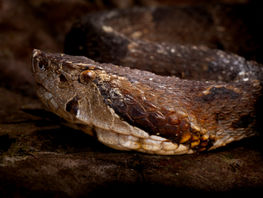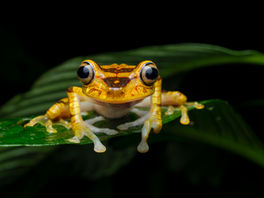Nature Reserve & Biological Station
Herpetological Research
A new focus of our research at Un poco del Chocó lies in the study and monitoring of amphibians and reptiles in and around our reserve. From January to March, we conduct nightly surveys to investigate their spatial ecology and other aspects of these fascinating creatures.

This juvenile Bothrops osbornei is a to southern colombia and northern ecuador endemic viper from the genus Bothrops. Even though they can have a similar physiology to Bothrops asper, they spend a lot of their life in the trees. We have found them resting exclusively arboreally. Once a 140cm individual in 4,9 meters height!!

Pristimantis achatinus, one of the most abundant frog species in our reserve.

Bolitoglossa sima, thats right!! We have arboreal salamanders!

This juvenile Bothrops osbornei is a to southern colombia and northern ecuador endemic viper from the genus Bothrops. Even though they can have a similar physiology to Bothrops asper, they spend a lot of their life in the trees. We have found them resting exclusively arboreally. Once a 140cm individual in 4,9 meters height!!
Annual Monitoring
After several species-inventories highlighted the incredible diversity of Amphibians and Reptilians (Herpetofauna) in the Un poco del Chocó Reserve, we initiated a monitoring project to investigate their densities, population sizes and annual demographic trends. We set up a total of six trail transects throughout the reserve to investigate frogs, salamanders, snakes and lizards. Our first sampling period was in 2025. In 3 months we observed 350 individuals of 29 species. All individuals were identified, weighed, measured, aged and sexed (if possible).
We base our transects on the principle of visual encounter survey distance sampling. This means we have standardized transects, on which we record everything we can see whilst moving at a certain pace. This allows us to estimate population sizes and densities by calculating encounter probabilities. This is one of the simplest, but most effective ways to estimate population sizes at finer scales.
We share our data with the Ecuadorian ministry for environment and international databases such as GBIF. This helps to better asess the health of populations and how they change.
Viper Focus
Additionally to trail transects, we catch and PIT-tag all Viperid Species. Ecuador has -relative to its size- an amazing diversity of Viper species of which many are highly understudied, and some are very real threats to public health. To better understand when and where snakebites happen, it is necessary to better understand movement patterns, reproductive events and population structure of these species.
To achieve this, additionally to transect data, we use the capture-mark-recapture (CMR) principle. This can help us to estimate population sizes at an even finer scale than solely transect data. It also enables us to monitor health, growth and movement of individual snakes.
.jpeg)

Future Opportunities
Additionally to our current research efforts which are largely based around the natural history of the Herpetofauna in Ecuador, we want to include genomic projects to better understand how the genetics behind venoms work and to help untangle the complex taxonomy of Ecuador's vipers.
We will also engage in small-scale public outreach projects to better protect people and animals.
Ethical Handling
We try hard to work by a very simple principle:
Keep the stress for the animal to a minimum, and get the most scientific value out of each encounter as possible.
We believe in multi-faceted projects. We run several questions simultaniously packaged in one survey and do this according to internationally accepted animal handling protocols and always refine our methods to get better results and stress animals as least as possible.

Are you interested in joining our herpetological research team?
Great!! There are many different ways of supporting our work!
>> You can participate in our ongoing research programs as a an intern and conduct a biological internship in Tropical Field Studies & Conservation.
>> You might be able to conduct a Research Traineeship in the reserve and work on your own research question (between Jan-Mar).
>> Or you can visit us for a shorter period of time and have look at our work and get close and personal with some of the amazing species you can find at Un poco del Chocó.
From our Blog....


















